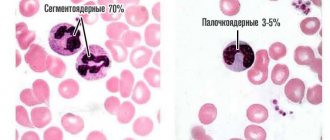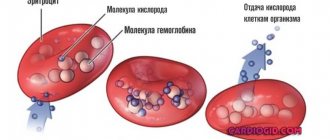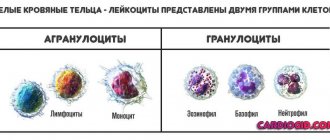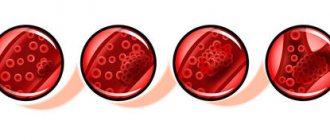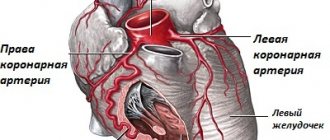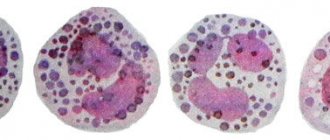Synonyms: neutrophil granulocytes, NEUT, neutrophil segmented granulocytes, polymorphonuclear neutrophils
There are six types of neutrophils depending on the stage of their maturation. Immature types include myeloblasts, promyelocytes, myelocytes, metamyelocytes and band cells. The final stage of development is segmented neutrophils (mature cells with a formed nucleus, divided into several segments).
Even at the stages of their initial development, neutrophils are able to resist infection, although mature segmented cells cope with this task much more effectively.
In blood tests of people suffering from severe infectious diseases, immature forms of neutrophils can be detected. This is explained by the fact that in the fight against pathogenic microorganisms, segmented cells die too quickly, and therefore the body is forced to use cells that are not fully mature. But in the blood of a healthy person, predominantly mature neutrophils are found, since they cope well with their task with virtually no help from their young brothers.
Figure 1. Phagocytosis. Image: mikrostoker/Depositphotos
Blood test for neutrophils
To determine the level of neutrophils, a complete blood count is used. To designate neutrophils on the analysis form, the Latin abbreviation NEUT is used, which can be expressed either in absolute (cell content per liter of blood, for example 0.04-0.3 × 109) or as a percentage. For general analysis, capillary blood is usually used. The biomaterial is collected from a finger after puncture with a scarifier. Sometimes blood is drawn from a vein - much depends on the methods the laboratory uses.
How effective is traditional and alternative medicine?
An even wider arsenal of ways to increase the level of leukocytes after using chemotherapy is offered by traditional and alternative medicine. The number of techniques and recipes is measured in tens and hundreds, if not thousands. There is no point in considering individual of them in detail. Alternative treatments are called that because they have not been clinically tested and their effectiveness has not been proven. Otherwise, all doctors – representatives of “official medicine” – would have adopted them long ago. Of course, no one forbids a person to use these methods on his own. But here, as in the case of dietary supplements, the principle works: the main thing is not to harm. Therefore, a preliminary consultation with your doctor is required.
Indications for analysis
A general blood test is the most common hematological test, so the range of indications for its use is wide. Neutrophils are a type of white blood cell whose main task is to destroy pathogenic microorganisms. Therefore, the main goal of the analysis for the content of neutrophils is to identify potentially dangerous conditions accompanied by infectious and inflammatory processes. In other words, a blood test for neutrophils can be informative both for colds and for kidney or liver diseases.
When is a test ordered?
Band neutrophils can be increased or decreased in patients of different genders and ages.
However, the study is prescribed if there are specific indications in the form of various symptoms and signs of diseases:
- Colds and inflammatory pathologies at the initial stage.
- Increased fatigue and weakness that does not disappear after a long rest.
- Loss of appetite and weight loss for no apparent reason.
- Decreased concentration and memory impairment.
- Dry skin, bleeding gums.
- Indigestion.
- Increased body temperature in the absence of other symptoms of the disease.
- Inflammatory pathologies of the liver, pancreas, gall bladder.
- Kidney diseases in acute and chronic stages.
- Suspicion of acute respiratory tract diseases.
- Oncological diseases in latent form.
- Infectious pathologies of the digestive tract.
- Blood pathologies characterized by a decrease in the level of red blood cells and hemoglobin.
Diagnostics can be prescribed for preventive purposes, which makes it possible to detect abnormalities at the initial stage. This analysis is a standard examination method, therefore, immediately upon admission of a patient to a hospital in any department, blood is drawn and tested. Thanks to the simplicity and speed of diagnostics, it is possible to identify deviations on the day the biomaterial is submitted.
Preparing for analysis
The study is carried out in the morning on an empty stomach, since food intake causes an increase in the number of neutrophils in the blood. Dinner on the eve of the test is allowed no later than eight o'clock in the evening. 2 days before the study, the patient should follow the following preparation rules:
- stop drinking alcohol;
- limit the consumption of spicy, fried and fatty foods;
- Avoid heavy physical activity and nervous stress.
The morning before the test you should not smoke. It is allowed to drink pure still water.
Figure 2. Preparation for donating blood for analysis.
Normal levels of neutrophils in the blood
The number of neutrophils in the blood is approximately 40-70% of the total leukocyte mass in both men and women.
When conducting research, experts primarily pay attention to the content of neutrophils at the middle and full stages of maturation, that is, band and segmented forms. Young cells are of interest if the development of the spread of inflammatory processes is suspected. The table shows the leukocyte formula, which reflects, among other things, the number of neutrophils. Table 1. Leukocyte formula with the number of neutrophils
| Index | × 10x9/l | Share as a percentage of the number of leukocytes | |
| Neutrophils | segmented | 2.0 – 5.5 | 40 — 70 |
| stab | 0.4 – 0.3 | 1 — 5 | |
| Basophils | Within 0.062 | Within 1.0 | |
| Eosinophils | 0.02 – 0.3 | 0.5 — 5 | |
| Lymphocytes | 1.0 – 3.2 | 17 — 38 | |
| Monocytes | 0.07 – 0.5 | 3 — 12 | |
In children of the first year of life, the number of band neutrophils can reach five, then the maximum value is limited to four, as in adults. The smallest number of segmented neutrophils is observed in children 4-5 years old (35-55%). In other age groups it varies between 40-70%.
Biologically active additives
As for dietary supplements and adaptogens, their ability to cope with low levels of white blood cells in cancer patients has not been proven. For example, astragalus and echinacea are very popular among patients, but their benefits in strengthening the immune system are questionable:
- In animal studies, astragalus actually helps strengthen the immune system. But such trials have not been conducted in humans, and it is not known whether the number of white blood cells in humans increases in the same way. But the risk of side effects is very real. Dietary supplements with astragalus may lead to diarrhea, low blood pressure, and dehydration.
- There have been no studies of echinacea in people with cancer, and it is unknown whether it can affect white blood cell counts and other blood parameters. However, it is known that echinacea is not very good for the liver and can increase the toxicity of some chemotherapy drugs.
Dietary supplements, vitamin complexes, adaptogens, herbal remedies - all these products are highly advertised and are very popular, including among cancer patients. Unfortunately, they are not always beneficial and are not always safe. It is especially undesirable to use them in parallel with chemotherapy, because they can affect the effects of anticancer drugs and increase their toxicity. Therefore, if a cancer patient still decides to use such drugs to increase the level of leukocytes, you must first consult with your doctor.
Causes of increased neutrophils in the blood
Elevated neutrophil levels can indicate a wide range of illnesses and injuries. Very often, the cause of an increase in neutrophils in the blood is infectious processes of bacterial origin, which can be either focal or generalized (spread throughout the body).
Reasons for increasing the level of neutrophils in the blood:
- upper respiratory tract infections (laryngitis, pharyngitis, sore throat);
- pneumonia;
- kidney diseases;
- diseases of the cardiovascular system;
- local purulent-inflammatory foci (abscesses, abscesses);
- viral diseases (measles, mumps, chickenpox, rubella, etc.);
- oncological diseases;
- taking hormonal medications;
- infections of bacterial origin (dysentery, tuberculosis, cholera, anthrax, etc.);
- poisoning with toxic substances;
- processes of tissue necrosis (gangrene, myocardial infarction, major burns);
- injuries of large organs;
- fractures;
- damage to the skin (cuts, abrasions, etc.);
- gout;
- sepsis (blood poisoning).
Eating canned foods can also cause an increase in neutrophils. This applies to those products in which there are no longer living bacteria left, but the toxic products of their vital activity have been preserved.
Causes of low levels of neutrophils in the blood
A decrease in the level of neutrophils in the blood is called neutropenia. The cause of this phenomenon can be diseases of various natures, as well as taking various medications.
Reasons for decreased neutrophil levels:
- infectious diseases (viral hepatitis, typhus, influenza, mononucleosis, etc.);
- autoimmune diseases (rheumatoid arthritis, systemic vasculitis, Crohn's disease, etc.);
- radiation sickness;
- blood diseases (leukemia, hemolytic and dyserythropoietic anemia).
Separate mention should be made of medications: taking them can also cause neutropenia. This is a very broad group of medications, which includes:
- NSAIDs (non-steroidal anti-inflammatory drugs: analgin, amidopyrine);
- antibacterial drugs (cephalosporins, penicillins);
- drugs to lower sugar (chlorpropamide);
- thyreostatic agents (propylthiouracil, Mercazolil);
- antimalarial drugs of synthetic origin (hydroxychloroquine);
- sulfonamides (sulfapyrazone; sulfasalazine);
- cytostatics (chlorambucil, methotrexate);
- antivirals (ganciclovir, zidovudine).
Figure 3. Blood cells in a healthy person and with neutropenia. Image: Sakurra/Depositphotos
Indicator 0
There is an indicator of 0 – what does this mean? Indicator 0 in a child and 0 in an adult can most often be provoked by the following factors:
- Bacterial infections such as typhus, tularemia or chronic brucellosis.
- Viral infections that can lead to a decrease in neutrophils. In such a situation, the patient may become ill with rubella, influenza, scarlet fever, measles, diphtheria or viral hepatitis.
- Toxic effects of medications.
- Anemia can cause a lack of neutrophils in an adult or child.
- Because of radiation.
Consequences of deviation of neutrophils from the norm
A change in the level of neutrophils in the blood is a signal from the body about the presence of inflammatory diseases, injuries or poisoning. Therefore, it is necessary to accurately determine the cause of the increase or decrease in neutrophils in order to begin treatment in time or eliminate the provoking factor. If this is not done on time, the consequences can be severe (even death). The greatest danger among possible causes is infectious diseases of a bacterial nature, as well as processes of local suppuration and necrotization (death) of tissue.
How to reduce the number of neutrophils in the blood
To reduce the number of neutrophils in the blood, it is necessary to influence the cause of this phenomenon, since there are no separate ways to eliminate it. If the increase in neutrophil levels is caused by short-term stress or increased physical activity, then no specific correction is required.
For persistent neutrophilia, depending on the disease that caused it, the following treatment methods are used:
- antimicrobial therapy - antibiotics are used for infections (amoxicillin, cefixime);
- antiplatelet therapy - in case of heart attack and a tendency to blood clots, acetylsalicylic acid and alteplase are prescribed;
- anti-inflammatory therapy - glucocorticosteroids (prednisolone) are used to reduce inflammation that provokes neutrophilia;
- chemotherapy – aimed at combating malignant tumors (cytostatics, antimetabolites).
If there is a local focus of inflammation, surgical treatment can be used. For example, it is relevant for appendicitis or abscesses. The menu should limit the amount of meat products, canned and smoked. The diet should be rich in vegetables and fruits.
To normalize the level of neutrophils in the blood, it is recommended to eat more vegetables and fruits. Photo: sommail / freepik.com
Doctor's recommendations
If the patient has a low level of neutrophils, the doctor informs the patient about lifestyle during the treatment process. First of all, it is necessary to reduce the risk of developing other diseases. It is worth paying attention to your diet. A person who has low neutrophil levels should not consume poorly processed meat products. At first, you need to boil the milk before drinking. Farm products should be excluded from your diet. It is better to buy goods from supermarkets, since products from the market often contain pathogenic microorganisms.
How to increase the number of neutrophils in the blood
To correct neutropenia, it is necessary to identify its cause. If a decrease in neutrophil levels is caused by taking medications, you should first weigh the possible risks of a decrease in neutrophil levels with the importance of the therapeutic effect of the drugs used. In extreme cases, the drug can be replaced with an analogue that does not affect the level of neutrophils in the blood. The underlying diseases that cause neutropenia are treated with antibiotics, anti-inflammatory and antiviral drugs.
It is recommended to consume the following products:
- any meat dishes (it is important that they are all well thermally processed);
- hard boiled eggs;
- pasteurized milk;
- cheese (except for varieties with mold);
- potato;
- rice;
- pasta;
- fruits and vegetables;
- alcohol only in consultation with a doctor.
Careful heat treatment of meat and eggs is necessary in order to exclude the possibility of bacteria and microbes entering the body, which actively multiply in poorly fried or undercooked protein dishes.
Does diet help increase white blood cell levels after chemotherapy?
There is currently no evidence that any foods help quickly normalize the level of white blood cells in the blood. This cannot be influenced in any way by eating certain types of food or, on the contrary, avoiding any dishes. However, the body can be helped a little by proper, nutritious nutrition:
- First of all, you need enough protein. The diet should regularly include foods such as meat, poultry, fish and seafood, eggs, milk, yogurt, cottage cheese, cereals, and legumes.
- Foods rich in vitamin B12 and folic acid, both of which are essential for normal blood formation, can help increase your white blood cell count. Liver, pork, beef, lamb, and turkey breast are rich in vitamin B12. Folic acid is found in offal, liver, asparagus, spinach, and flaxseed oil. You can take vitamins purchased at the pharmacy.
If you want to receive competent recommendations on nutrition in order to return the number of leukocytes to normal after cancer treatment and generally restore the body’s resources, it is better to consult a nutritionist.
